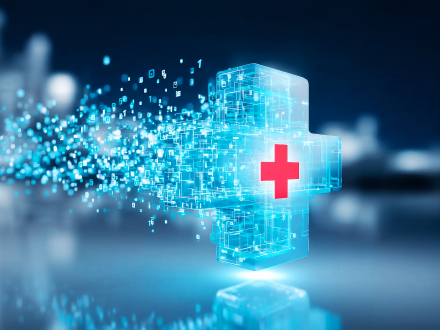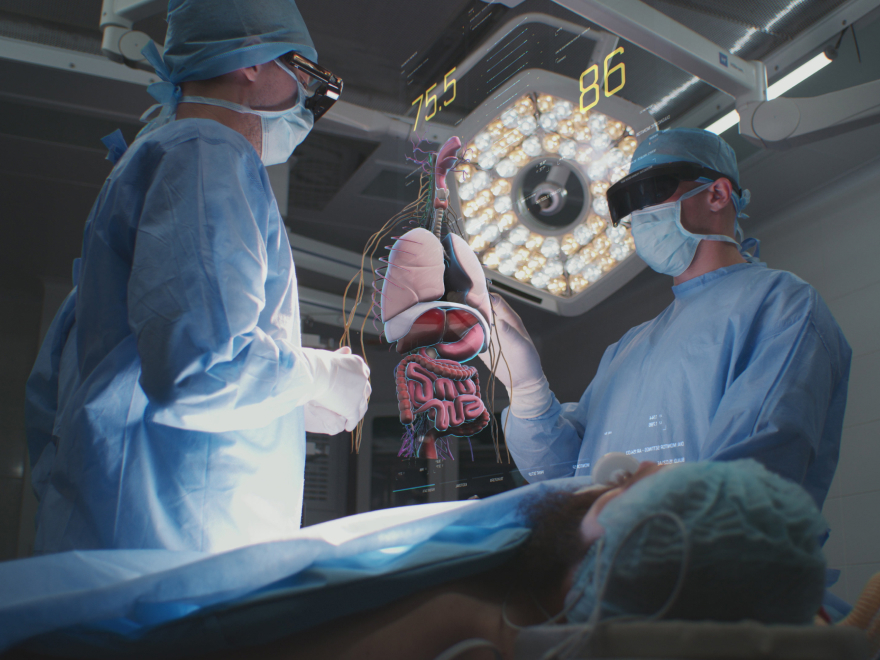Ditt meddelande har skickats.
Vi behandlar din begäran och återkommer till dig så snart som möjligt.
Formuläret har skickats in framgångsrikt.
Ytterligare information finns i din brevlåda.


Det är bara att erkänna att sjukvården kan vara lite av en gissningslek - men tänk om vi hade en kristallkula? Prediktiv analys håller på att bli den kristallkulan och använder kraften i data för att omvandla sjukvården från reaktiv till proaktiv: vi talar om allt från att upptäcka hälsorisker innan de blir stora problem till att se till att sjukhusen har rätt förnödenheter till hands och till och med att ta bedragare på bar gärning. Läs vidare för att se hur prediktiv analys förändrar spelreglerna inom sjukvården, en datapunkt i taget.
Prediktiv analys inom sjukvården handlar om att använda statistiska algoritmer och maskininlärningstekniker för att identifiera sannolikheten för framtida utfall baserat på historiska data. Genom att analysera komplexa mönster i patientjournaler, behandlingshistorik och demografi kan sjukvårdsorganisationer identifiera högriskpatienter med större noggrannhet än någonsin tidigare och utveckla riktade insatser.
Denna datadrivna strategi förändrar förutsättningarna för hälso- och sjukvården. På patientnivå innebär det optimerade behandlingsplaner, minskad sannolikhet för återinläggningar och förbättrad sjukdomshantering. På en bredare skala stärker prediktiv analys hanteringen av befolkningens hälsa, optimerar vårdkvaliteten och sänker vårdkostnaderna. I slutändan har prediktiv analys potential att skapa ett mer effektivt och patientcentrerat ekosystem för hälso- och sjukvård som gynnar alla intressenter.
Siffrorna talar för sig själva: sjukvårdsbranschen satsar stort på prediktiv analys. Den globala marknaden förväntas skjuta i höjden och uppgå till svindlande $154,61 miljarder år 2034, och företagen inser tydligt att den här tekniken kan förändra spelplanen. Den kraftiga ökningen av investeringar visar att branschen rör sig mot proaktiva, datadrivna lösningar för hälso- och sjukvårdoch till stor del avskaffa reaktiva tillvägagångssätt. Vi ser ett stort språng från en marknad på $14,51 miljarder 2023 till en beräknad marknad på $17,99 miljarder 2024: detta visar den snabba takten i införandet och den enorma tillväxt som förutspås för de kommande åren. Det råder ingen tvekan om att prediktiv analys är på väg att leda till en revolution inom sjukvården.
Låt oss gå bortom hypen och utforska de konkreta sätt på vilka prediktiv analys revolutionerar sjukvården, här och nu.
Prediktiv analys inom sjukvården hjälper oss att identifiera och gruppera patienter utifrån deras hälsorisker. Det innebär en mer proaktiv inställning till vården med riktade insatser, optimerad resursfördelning (t.ex. för högriskindivider) och personliga vårdplaner.

Individanpassad behandling planer, tidig upptäckt av sjukdomar, optimerad resursfördelning, förbättrad efterlevnad av kliniska riktlinjer och stöd för hantering av befolkningens hälsa - allt detta är möjligt tack vare prediktiv analys - förändrar det kliniska beslutsfattandet.

Prediktiv analys förändrar sjukvårdsorganisationernas sätt att arbeta. Prediktiv analys påverkar allt från resursallokering till lagerhantering, förebyggande av återinläggningar till underhåll av utrustning. Och det bästa av allt? Förbättringarna leder till ökad effektivitet och högre vårdkvalitet.

Genom att använda data från olika källor hjälper prediktiv analys vårdgivare att identifiera högriskpopulationer, förutse sjukdomsutbrott och skräddarsy insatser med hjälp av ett datadrivet tillvägagångssätt. Detta gör det möjligt för vårdgivare att lägga resurser där de behövs mest - rikta in sig på specifika demografier med skräddarsydda program för att tillgodose deras unika hälsobehov.

Prediktiv analys gör det möjligt för vårdpersonal att nå ut till patienterna på ett personligt sätt och ingripa vid behov. Det hjälper till att upptäcka patienter som löper större risk att förlora kontakten, så att vårdpersonalen kan ge dem det stöd och den information de behöver. Detta datadrivna tillvägagångssätt innebär att människor bättre kan förstå sin vård och bli mer delaktiga i sin behandling.

Tack vare avancerade tekniker för prediktiv analys kan vårdgivare upptäcka och stoppa oseriösa aktörer innan de orsakar någon skada. Dessa tekniker hjälper till att förhindra identitetsstölder och andra bedrägerier för att säkerställa att patienterna endast faktureras för de tjänster de faktiskt får och skyddar både patienter och vårdgivare från ekonomiska bedrägerier.

Prediktiv analys är nyckeln till att förebygga lageravbrott och stärka leveranskedjorna inom sjukvården. Genom att prognostisera efterfrågan och optimera inventering kan leverantörerna justera inköpen i realtid - vilket i sin tur säkerställer en tillförlitlig och jämn ström av medicinskt material och utrustning.

Prediktiv analys inom sjukvården hjälper oss att identifiera och gruppera patienter utifrån deras hälsorisker. Det innebär en mer proaktiv inställning till vården med riktade insatser, optimerad resursfördelning (t.ex. för högriskindivider) och personliga vårdplaner.

Individanpassad behandling planer, tidig upptäckt av sjukdomar, optimerad resursfördelning, förbättrad efterlevnad av kliniska riktlinjer och stöd för hantering av befolkningens hälsa - allt detta är möjligt tack vare prediktiv analys - förändrar det kliniska beslutsfattandet.

Prediktiv analys förändrar sjukvårdsorganisationernas sätt att arbeta. Prediktiv analys påverkar allt från resursallokering till lagerhantering, förebyggande av återinläggningar till underhåll av utrustning. Och det bästa av allt? Förbättringarna leder till ökad effektivitet och högre vårdkvalitet.

Genom att använda data från olika källor hjälper prediktiv analys vårdgivare att identifiera högriskpopulationer, förutse sjukdomsutbrott och skräddarsy insatser med hjälp av ett datadrivet tillvägagångssätt. Detta gör det möjligt för vårdgivare att lägga resurser där de behövs mest - rikta in sig på specifika demografier med skräddarsydda program för att tillgodose deras unika hälsobehov.

Prediktiv analys gör det möjligt för vårdpersonal att nå ut till patienterna på ett personligt sätt och ingripa vid behov. Det hjälper till att upptäcka patienter som löper större risk att förlora kontakten, så att vårdpersonalen kan ge dem det stöd och den information de behöver. Detta datadrivna tillvägagångssätt innebär att människor bättre kan förstå sin vård och bli mer delaktiga i sin behandling.

Tack vare avancerade tekniker för prediktiv analys kan vårdgivare upptäcka och stoppa oseriösa aktörer innan de orsakar någon skada. Dessa tekniker hjälper till att förhindra identitetsstölder och andra bedrägerier för att säkerställa att patienterna endast faktureras för de tjänster de faktiskt får och skyddar både patienter och vårdgivare från ekonomiska bedrägerier.

Prediktiv analys är nyckeln till att förebygga lageravbrott och stärka leveranskedjorna inom sjukvården. Genom att prognostisera efterfrågan och optimera inventering kan leverantörerna justera inköpen i realtid - vilket i sin tur säkerställer en tillförlitlig och jämn ström av medicinskt material och utrustning.

"Prediktiv analys inom sjukvården är ännu mer än att ge läkarna en kristallkula. Det handlar om precision, inte gissningar, som gör det möjligt för vårdpersonal att anpassa vården och optimera resurserna. Den här tekniken förbättrar inte bara patientresultaten; den förändrar helt hur vårdsektorn fungerar genom att förutse behov och förebygga problem långt innan de uppstår. Det är en game-changer inom proaktiv sjukvård."

Aleh Yafimau
Leveransansvarig på Innowise
Det här avsnittet handlar om hur sjukvårdsinstitutioner kan dra nytta av prediktiv analys - från att se till att patienter får rätt behandling till att effektivisera kliniska arbetsflöden och fatta bättre underbyggda strategiska beslut. Ta reda på hur dessa verktyg ger liv åt en ny era av datadriven hälso- och sjukvård.
Dessa är centrala knutpunkter för uppgifter om hälso- och sjukvård, integrera information från Elektroniska patientjournaleroch skadedatabaser, bärbara produkteroch andra källor. Dessa plattformar använder avancerad analys och maskininlärning för att identifiera trender, förutse framtida händelser och ge insikter till intressenter. Naturlig språkbehandling kan hjälpa till att förutse framtida händelser genom att hitta användbar information i ostrukturerade kliniska anteckningar. Datastyrning och integritet är dock viktiga för att dessa plattformar ska kunna användas på ett ansvarsfullt sätt.
Med hjälp av djupinlärning kan dessa verktyg analysera medicinska bilder som röntgen, datortomografi och magnetröntgen med allt högre precision. Nya studier har visat lovande resultat inom områden som cancerdetektering, diagnostisering av diabetesretinopati och identifiering av kardiovaskulära avvikelser - ofta överträffar de den mänskliga prestationen i specifika uppgifter. Dessa verktyg används i allt större utsträckning för triage inom radiologi, för att prioritera brådskande fall och förbättra effektiviteten i arbetsflödet. Det är värt att notera att verktygen inte är utformade för att ersätta läkarna, utan för att stödja dem.
Dessa system är avgörande för att hantera överbeläggningar och sängtilldelning på sjukhus. Genom att exakt förutsäga faktorer som akutmottagningar, utskrivningstider och resursutnyttjande kan sjukhusen optimera bemanningen, minska väntetiderna och förbättra den övergripande effektiviteten i verksamheten. Dessutom integrerar dessa system nu realtidsdata från IoT-enheter för att ge ännu mer exakta förutsägelser och optimera resursallokeringen dynamiskt.
Farmakogenomik är ett viktigt användningsområde för dessa plattformar, där man analyserar hur en individs genetiska uppsättning påverkar hur han eller hon reagerar på läkemedel. Detta möjliggör individanpassade läkemedelsval och dosoptimering - vilket leder till förbättrade behandlingsresultat och minskade läkemedelsbiverkningar. För en mer heltäckande metod utvidgas dessa plattformar nu till att omfatta mer än farmakogenomik och inkluderar även andra "omics"-data, t.ex. proteomik eller metabolomik.
Hantering av kroniska sjukdomar är ett bra exempel på en situation där denna programvara är en vinnare. Genom att identifiera patienter som löper hög risk för komplikationer eller sjukhusvistelse kan vårdgivarna proaktivt vidta åtgärder, samordna vårdplaner och uppmuntra patienterna att följa sin medicinering - vilket i slutändan minskar vårdkostnaderna och förbättrar patientresultaten. För att kunna ge en mer holistisk 360-gradersbild av patientriskerna integrerar dessa system i allt högre grad även data om sociala bestämningsfaktorer för hälsa.
När de är kopplade till journalsystem kan kliniska beslutsstödsystem (CDSS) ge läkare varningar och råd i realtid, precis när de behöver det. Tänk på det som att ha en digital assistent som kan flagga för potentiella läkemedelsinteraktioner, föreslå lämpliga diagnostiska tester baserat på symtom och rekommendera evidensbaserade behandlingsriktlinjer - allt för att hjälpa läkarna att fatta bättre underbyggda beslut på plats. Moderna CDSS börjar också införliva de senasteAI-teknikerna - till exempel förstärkningsinlärning - som finjusterar rekommendationerna baserat på tidigare resultat.
Dessa system analyserar enorma mängder data för att upptäcka ovanliga mönster eller oegentligheter. Genom att använda maskininlärning kan de flagga anspråk som kan vara bedrägliga för vidare utredning - vilket sparar sjukvårdsbetalare miljontals dollar per år och håller systemet rättvist och korrekt. Dessa system hjälper också till att upptäcka felaktig kodning och faktureringsfel, så att allt går rätt till.
Dessa verktyg använder prediktiva modeller för att hitta riskpopulationer och anpassa sina folkhälsoinsatser därefter. De kan till exempel förutse vilka områden som har hög sannolikhet för sjukdomsutbrott, vilket möjliggör riktade vaccinationskampanjer eller resursallokering för att mildra potentiella folkhälsokriser. Dessutom kan de anpassa patientkommunikationen - vilket förbättrar följsamheten till förebyggande undersökningar och främjar hälsosamma beteenden.
Att ta steget till datadriven hälso- och sjukvård kan vara skrämmande - men det behöver det inte vara. På Innowise banar vi väg för en smidig övergång och levererar verkliga resultat. Vi gör mer än att installera programvara: vi ger ditt team kunskapen och verktygen för att frigöra den fulla potentialen i dina data.
Att utvinna användbara insikter ur komplexa vårddata är hörnstenen i effektiv prediktiv analys. Våra datavetenskapliga experter är redo att gräva fram dolda mönster, bygga anpassade prediktiva modeller och leverera konkret, datadriven intelligens som vägledning för dina stora beslut.

Vårt team har många års erfarenhet av att utforma anpassade lösningsarkitekturer som passar varje kunds unika processer, datainfrastruktur och mål. Vi ser till att våra system fungerar med det du redan har, så att du kan få ut mer av din prediktiva analys, maximera värdet och se verkliga resultat.

Vi finns här för dig varje steg på vägen - från att konfigurera ditt system och överföra data till att utbilda ditt team och erbjuda allt-i-ett-support under lanseringen. Vi ser till att övergången till din nya plattform för prediktiv analys blir så stressfri och smidig som möjligt.

Våra experter gör det enkelt att flytta data från dina nuvarande system till din nya plattform för prediktiv analys - så att allt fungerar smidigt samtidigt som du får tillgång till den data du behöver för att fatta beslut. Genom att göra integrationen enkel hjälper vi våra kunder att få ut mesta möjliga av prediktiv analys och förvandla sina data till konkreta tillgångar.

Vi erbjuder löpande support- och underhållstjänster för att hålla din prediktiva analyslösning igång på bästa sätt. Vårt team är tillgängligt för att ta itu med tekniska problem, svara på frågor och ge vägledning för att maximera din investering - för att inte tala om att hålla ditt system uppdaterat med de senaste funktions- och säkerhetsuppdateringarna.

Att utvinna användbara insikter ur komplexa vårddata är hörnstenen i effektiv prediktiv analys. Våra datavetenskapliga experter är redo att gräva fram dolda mönster, bygga anpassade prediktiva modeller och leverera konkret, datadriven intelligens som vägledning för dina stora beslut.

Vårt team har många års erfarenhet av att utforma anpassade lösningsarkitekturer som passar varje kunds unika processer, datainfrastruktur och mål. Vi ser till att våra system fungerar med det du redan har, så att du kan få ut mer av din prediktiva analys, maximera värdet och se verkliga resultat.

Vi finns här för dig varje steg på vägen - från att konfigurera ditt system och överföra data till att utbilda ditt team och erbjuda allt-i-ett-support under lanseringen. Vi ser till att övergången till din nya plattform för prediktiv analys blir så stressfri och smidig som möjligt.

Våra experter gör det enkelt att flytta data från dina nuvarande system till din nya plattform för prediktiv analys - så att allt fungerar smidigt samtidigt som du får tillgång till den data du behöver för att fatta beslut. Genom att göra integrationen enkel hjälper vi våra kunder att få ut mesta möjliga av prediktiv analys och förvandla sina data till konkreta tillgångar.

Vi erbjuder löpande support- och underhållstjänster för att hålla din prediktiva analyslösning igång på bästa sätt. Vårt team är tillgängligt för att ta itu med tekniska problem, svara på frågor och ge vägledning för att maximera din investering - för att inte tala om att hålla ditt system uppdaterat med de senaste funktions- och säkerhetsuppdateringarna.

Upptäck hur du kan höja nivån på din analys av hälso- och sjukvården
Prediktiv analys inom sjukvården erbjuder en mängd fördelar som förbättrar patientvården, ökar verksamhetens effektivitet och minskar kostnaderna. Här följer en detaljerad genomgång av dessa fördelar.
Genom att ta hänsyn till bland annat följsamhet till medicinering och samsjuklighet kan prediktiva modeller flagga för patienter som löper hög risk att utveckla sjukdomar som diabetes. Detta banar väg för förebyggande åtgärder eller behandlingar som kan sättas in snabbt - vilket potentiellt kan rädda liv.
Prediktiv analys möjliggör precisionsmedicin genom att analysera genomdata, biomarkörer och behandlingsresultat. Inom onkologin hjälper prediktiva modeller till exempel till att avgöra vilka patienter som är mer benägna att svara på specifika kemoterapiregimer - vilket minskar antalet onödiga behandlingar och de biverkningar som följer med dem.
Prediktiva modeller är mycket användbara för att upptäcka tidiga tecken på försämring hos patienter. MEWS-systemet (Modified Early Warning Score) använder data från vitalparametrar för att förutsäga vilka patienter som sannolikt kommer att behöva intensivvård inom 24 timmar, vilket gör det möjligt att ingripa vid rätt tidpunkt.
För tillstånd som diabetes kan prediktiv analys hjälpa till att förutse blodsockernivåer baserat på faktorer som vad en patient äter, hur mycket de motionerar och deras nuvarande medicinering. Detta innebär att patienterna får mer exakta insulindoser och bättre livsstilsråd.
Avancerad teknik förstärker det mänskliga omdömet och bearbetar information snabbare och mer exakt. Det är en reservplan som skyddar läkare från misstag vid förskrivning av läkemedel och hjälper till att upptäcka potentiella problem med allergier, överkänslighet och dubbeldosering.
Personanpassade behandlingar, med stöd av prediktiv analys, har visat sig kunna minska vårdkostnaderna avsevärt. A studie av JAMA Network fann att personliga behandlingsplaner ledde till en 35% minskning av negativa utfall för patienterna - vilket i sin tur resulterade i färre återinläggningar på sjukhus, ett högre förebyggande av negativa händelser och bättre resursfördelning.
Att införa prediktiv analys i hälso- och sjukvårdssystem innebär ett antal specifika utmaningar som kräver genomtänkta lösningar. På Innowise är vi dedikerade till att hjälpa våra kunder att övervinna dessa hinder genom att använda avancerade verktyg och strategier som är skräddarsydda för sjukvården.
Kontakta oss idag för att utforska våra skräddarsydda lösningar.
Prediktiv analys kommer att i grunden förändra det sätt på vilket sjukvårdsinstitutioner hanterar och levererar sina tjänster. Med framsteg inom maskininlärning och artificiell intelligens i sikte kommer de att kunna analysera alltmer komplexa och stora datamängder och göra mer exakta förutsägelser och individanpassade insatser.
Integrationen av genomik och prediktiv analys kommer att vara avgörande för att förstå de genetiska faktorer som påverkar sjukdomar. Detta kommer att bana väg för personliga behandlingsplaner baserade på en individs genetiska sammansättning.
Realtidsdata från bärbar teknik kommer att hjälpa vårdgivare att gå från att förutse framtida risker till att identifiera förestående hälsohändelser. Föreställ dig en framtid där en hjärtattack eller diabetesepisod kan förutses och potentiellt förhindras - det låter ganska bra, eller hur?
Utöver vård av enskilda patienter kommer prediktiv analys att spela en avgörande roll inom folkhälsan. Baserat på analys av data från flera källor kan utbrott och epidemier upptäckas tidigare, vilket leder till snabbare responstider och effektivare begränsning av effekterna. Dessutom kan regeringar använda prediktiva modeller för att simulera effekterna av hälsopolitiken och fatta mer välgrundade beslut om resursfördelning och folkhälsoinsatser.
Kombinationen av dessa olika faktorer ger en bild av en framtid där prediktiv analys är en integrerad del av ett mer proaktivt, individanpassat och effektivt sjukvårdssystem.

Integreringen av prediktiv analys flyttar fokus inom sjukvården från reaktiva insatser till proaktiv, individanpassad medicin. Genom att förutse potentiella hälsorisker kan vårdgivarna agera innan mindre problem hinner bli allvarliga - vilket förbättrar patientresultaten och optimerar vårdresurserna.
Detta datadrivna tillvägagångssätt stöder personlig medicin - det vill säga skräddarsydda behandlingsplaner baserade på individuella patientprofiler och genetiska anlag. Denna målinriktade strategi förbättrar inte bara vårdens effektivitet utan innebär också att läkarna får ut mesta möjliga av sina resurser genom att minimera onödiga ingrepp.
Med detta sagt är det ingen överraskning att etiska överväganden relaterade till integritet och säkerhet bör behandlas noggrant. När vi fortsätter att använda prediktiva analyser i våra arbetsflöden är det viktigt att patienternas integritet har högsta prioritet och att vi ser till att datahanteringen sker på ett ansvarsfullt sätt. Vårdpersonalen måste få den kunskap och de verktyg de behöver för att kunna tolka och använda dessa prediktiva insikter - vilket maximerar fördelarna för både enskilda patienter och vårdsystemet som helhet.
Prediktiv analys bygger på ett brett spektrum av datatyper: från strukturerade data som patientdemografi och laboratorieresultat till ostrukturerade data som läkaranteckningar och medicinska bilder. Tidsseriedata avslöjar trender, transaktionsdata spårar patientflöden och geospatiala data kartlägger sjukdomsutbrott, medan beteendedata ger unika, evidensbaserade insikter i patienternas agerande. Genom att kombinera dessa datatyper får man en heltäckande, allt-i-ett-vy över patientens hälsostatus.
Det är en självklarhet att vårdorganisationer ska prioritera datasekretess och datasäkerhet. Kryptering av data, kontroll av åtkomst och anonymisering av information är inte förhandlingsbart - liksom fullständig efterlevnad av bestämmelser som HIPAA och GDPR. Regelbunden personalutbildning, säkerhetsrevisioner och samarbete med IT-experter är till stor hjälp när det gäller att skydda patienternas integritet och samtidigt utnyttja prediktiva analyser.
Maskininlärning och AI är grundläggande för modern prediktiv analys. De har en överlägsen förmåga att bearbeta stora datamängder från sjukvården, upptäcka dolda mönster och kontinuerligt lära sig av ny information för att förbättra förutsägelserna. Detta möjliggör mer exakta riskbedömningar, individanpassade interventioner och effektiv resursallokering.
Prediktiv analys har en omvälvande potential inom olika områden, men tillämpningen bör styras av noggranna överväganden av ett antal etiska principer - inklusive men inte begränsat till integritet, partiskhet, samtycke och ansvarsskyldighet, liksom transparens, påverkan på sysselsättningen, säkerhetsrisker och manipuleringspotential. Det är också viktigt att beakta aspekter som rör efterlevnad av regelverk samt långsiktiga samhällseffekter.













Ditt meddelande har skickats.
Vi behandlar din begäran och återkommer till dig så snart som möjligt.

Genom att registrera dig godkänner du vår Integritetspolicy, inklusive användning av cookies och överföring av din personliga information.